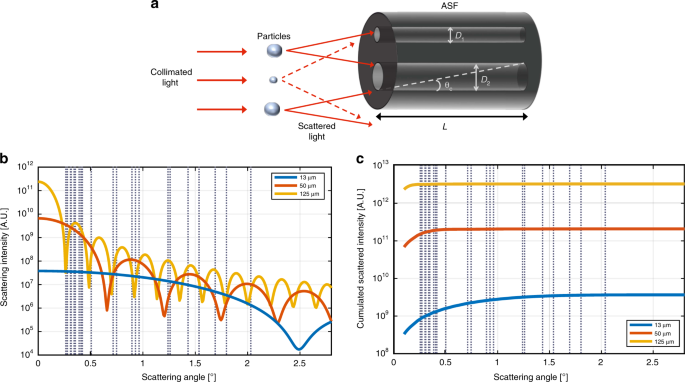Increasing Production Efficiency with an Optical Fibre Diameter Analyser
Increasing Production Efficiency with an Optical Fibre Diameter Analyser
Blog Article
Enhance Your Fibre Optic Projects With a Reliable Size Analyser
The integration of an effective diameter analyser right into fibre optic jobs works as an essential element in attaining accuracy and uniformity. By helping with precise diameter dimensions, these analysers not just enhance the high quality of installations yet also alleviate potential compatibility issues amongst parts. Moreover, the advanced capacities of contemporary analysers enhance data collection and quality assurance procedures. As we explore the crucial attributes and benefits of these devices, it comes to be apparent just how they can change job outcomes and make sure adherence to market standards. What stays to be reviewed is just how to effectively carry out these analysers in your existing workflows.
Value of Diameter Measurement
Determining the diameter of fibre optic cords is a critical job that guarantees optimal efficiency and reliability in interaction systems. Accurate diameter dimension is crucial for numerous factors, primarily for keeping signal honesty and reducing loss. A cable television's size directly affects its ability to transfer light effectively; discrepancies from the specified diameter can bring about boosted depletion, which influences the total performance of the network.
In addition, accurate dimension is essential during the installment and upkeep of fiber optic systems. An inappropriate fit in between adapters and wires can result in signal destruction or full failing of interaction links. By making certain that diameters are within defined resistances, professionals can enhance compatibility in between parts, causing improved system dependability.
In addition, size measurement plays a significant role in top quality control throughout production. Consistency in the diameter of fibre optic wires is crucial for guaranteeing uniform performance across various batches. optical fibre diameter analyser. This uniformity helps makers maintain sector standards and cultivates self-confidence amongst end-users
Features of an Effective Analyser
An efficient analyser for fiber optic projects have to incorporate several key functions that enhance accuracy and usability in size dimension. High-resolution optical sensors are crucial for accurate diameter readings, making it possible for users to spot even the tiniest variants in fibre thickness. These sensors need to be enhanced by sophisticated calibration systems, making certain regular performance across various problems and materials.
Secondly, an easy to use user interface is vital for assisting in ease of procedure. This consists of user-friendly software application that permits smooth data input and result, in addition to visual depictions of the measurements taken. A mobile design improves use in different field atmospheres, making it much easier to perform evaluations on-site.
Additionally, the analyser needs to support several measurement modes, suiting various fiber types and applications. The capability to shop and obtain historic information is one more crucial attribute, enabling customers to track performance with time and make notified decisions.
Benefits for Fiber Optic Projects
Carrying out a diameter analyser in fibre optic tasks supplies considerable benefits that substantially enhance job efficiency and top quality. One of the main benefits is the ability to guarantee exact dimensions of fiber size, which is crucial for preserving optimal efficiency in fiber optic systems. Exact diameter readings aid in the recognition of variances that might result in signal degradation or loss, hence making certain high-grade transmission.
Furthermore, making use of a size analyser enhances the quality assurance procedure. By automating dimension tasks, task teams can reduce the moment spent on manual examinations, bring about faster task completion and lowered labour costs. This performance also permits more rigorous testing methods, leading to improved product reliability.
Furthermore, consistency in fibre size dimensions advertises compatibility with various other fibre optic components, decreasing the danger of installment mistakes and improving overall system efficiency. The incorporation of a size analyser not just help in maintaining industry standards yet also cultivates self-confidence in job deliverables.
Combination Into Existing Process
Incorporating a diameter analyser right into existing process can significantly boost the read this article operational efficiency of fibre optic projects. By perfectly including this technology, groups can accomplish exact measurements that are critical to maintaining the stability and efficiency of fiber optic systems. This combination allows for real-time data collection and analysis, which can be critical throughout the manufacturing and installment stages.
Furthermore, the capacity to automate diameter measurement processes lowers the capacity for human error, guaranteeing consistent quality assurance throughout the task lifecycle. The information generated can be conveniently shared throughout platforms, assisting in cooperation among designers, professionals, and job supervisors. This ease of access boosts decision-making and speeds up project timelines.

Selecting the Right Diameter Analyser
When picking a size analyser for fiber optic tasks, it is important to take into consideration a number of key variables that directly effect dimension accuracy and functional effectiveness. The resolution and accuracy of the analyser must align with the details needs of your job. Greater resolution instruments can discover minute variants in size, which is critical for making sure ideal performance in fibre optic systems.
Following, examine the speed of dimension. For jobs with tight deadlines, a size analyser that supplies fast information acquisition can significantly improve productivity. Furthermore, consider the analyser's compatibility with existing systems and software application. A seamless integration decreases configuration time and reduces interruptions throughout procedures.
Another important variable is the range of sizes the analyser can suit. By thoroughly evaluating these factors, you can select a size analyser that enhances the performance and accuracy of your fibre optic tasks.
Conclusion
In conclusion, the combination of an go to my site efficient size analyser is critical for improving fiber optic tasks. Specific diameter dimensions guarantee ideal performance and reliability while decreasing setup mistakes (optical fibre diameter analyser).
A cable's diameter directly influences its capacity to transfer light properly; deviations from the defined diameter can lead to enhanced attenuation, which affects the overall performance of the network.

Report this page